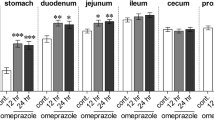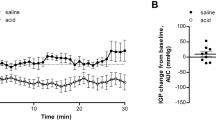Abstract
Effects of indomethacin on gastric motility and secretion, and levels of endogenous prostaglandins (PGs) were investigated in rats, in attempts to elucidate the factors involved in the pathogenesis of indomethacin-induced macroscopic gastric lesions. Subcutaneous administration of indomethacin had no effect on the gastric mucosa at doses of 1 and 5 mg/kg, but induced visible lesions dose dependently at over 10 mg/kg within 4 hr. At 25 mg/kg, there were apparent nonhemorrhagic lesions within 1 hr, and these lesions became hemorrhagic with time. Acid secretion was not affected by this agent at either dose level, but pepsin or acid-induced HCO3 − secretion was significantly increased or decreased, respectively, at a dose less than 5 mg/kg, which did not induce any lesion. Gastric motility, however, was dose dependently increased after administration of indomethacin, and its effect was significant at 10 mg/kg or greater. Time-course changes in the motility were in parallel with those of the lesion formation. PGE2 and 6-keto PGF1α levels in the corpus mucosa were reduced around 80–90% for more than 4 hr from 30 min after administration of 5 mg/kg or more of indomethacin. When all the above changes caused by indomethacin were plotted for the various doses, a significant correlation (r=0.958, P<0.01) was found between the lesion index and the changes in motility, but not in other factors, including PG levels. These results indicate that gastric motility may be an important factor in the pathogenetic mechanism of indomethacin-induced gastric lesions in rats. A deficiency of endogenous PGs may be a prerequisite for later extension of the lesions.
Similar content being viewed by others
References
Djahanguiri B: The production of acute gastric ulceration by indomethacin in the rat. Scand J Gastroenterol 4:265–267, 1969
Lanza FL: Endoscopic studies of gastric and duodenal injury after the use of ibuprofen, aspirin, and other nonsteroidal antiinflammatory agents. Am J Med 77:19–24, 1984
Robert A: Prostaglandins and the gastrointestinal tract.In Physiology of the Gastrointestinal Tract. LR Johnson, J Christensen, MI Grossman, ED Jacobson, SG Schultz (eds). New York, Raven Press, 1981, pp 1407–1434
Mersereau WA, Hinchey EJ: Prevention of indomethacin induced gastric hypercontractility: A mucosal protective mechanism of prostaglandin E2. Gastroenterology 78:1221, 1980 (abstract)
Mersereau WA, Hinchey EJ: Prevention of phenylbutazone ulcer in the rat by glucose: Role of a glycoprivic receptor system. Am J Physiol 242:G429-G432, 1982
Anson ML: The estimation of pepsin, trypsin, papain and cathepsin with hemoglobin. J Gen Physiol 22:79–89, 1938
Takeuchi K, Ohtsuki H, Okabe S: Mechanisms of protective activity of 16,16-dimethyl PGE2 and acetazolamide on gastric and duodenal lesions in rats. Dig Dis Sci (in press)
Takeuchi K, Nobuhara Y: Inhibition of gastric motor activity by 16,16-dimethyl prostaglandin E2: A possible explanation of cytoprotection. Dig Dis Sci 30:1181–1188, 1985
Arakawa T, Nakamura H, Chono S, Yamada H, Kobayashi K: Prostaglandin E2 in the rat gastric mucosa (first report); Establishment of assay procedure and effects of nonsteroidal antiinflammatory compounds. Jpn J Gastroenterol 77:8–15, 1980
Orcyk GP, Behrnam HR: Ovulation blockade by aspirin or indomethacin;in vivo evidence for a role of PGs in gonadotrophin secretion. Prostaglandins 1:3–20, 1972
Dunnett CW: A multiple comparison procedure for comparing several treatments with a control. Am J Stat Assoc 50:1096–1121, 1955
Lippman W: Inhibition of indomethacin-induced gastric ulceration in the rat by perorally administered synthetic and natural prostaglandin analogues. Prostaglandins 7:1–9, 1974
Tabata K, Okabe S: Effects of 16,16-dimethyl prostaglandin E2 methyl ester on aspirin- and indomethacin-induced gastrointestinal lesions in dogs. Dig Dis Sci 25:439–448, 1980
Main IM, Whittle BJR: Investigation of the vasodilator and antisecretory role of prostaglandins in the rat gastric mucosa by use of nonsteroidal antiinflammatory drugs. Br J Pharmacol 53:217–224, 1975
Robert A: Antisecretory, antiulcer, cytoprotective and diarrhogenic properties of prostaglandins.In Advances in Prostaglandin and Thromboxane Research, Vol II. B Samuelsson, R Paoletti (eds). New York, Raven Press, 1976, pp 507–520
Whittle BJR: Temporal relationship between cyclooxygenase inhibition, as measured by prostacyclin biosynthesis, and the gastrointestinal damage induced by indomethacin in the rat. Gastroenterology 80:94–98, 1981
Ligmusky M, Golanska EM, Hansen DG, Kauffman GL: Aspirin can inhibit gastric mucosal cyclooxygenase without causing lesions in rats. Gastroenterology 84:756–761, 1983
Kasuya Y, Urushidani T, Okabe S: Effects of various drugs and vagotomy on indomethacin-induced gastric ulcers in the rat. Jpn J Pharmacol 29:670–673, 1979
Okabe S, Takeuchi K, Kunimi H, Kanno M, Kawashima M: Effects of an antiulcer drug, sucralfate (a basic aluminum salt of sulfated disaccharide) on experimental gastric lesions and gastric secretion in rats. Dig Dis Sci 28:1034–1042, 1983
Cooke AR: The role of the mucosal barrier in drug-induced gastric ulcerations and erosions. Am J Dig Dis 21:155–164, 1976
Heylings JR, Garner A, Flemstrom G: Regulation of gastroduodenal HCO3 − transport by luminal acid in the frogin vitro. Am J Physiol 246:G235-G242, 1984
Van Kolfschoten AA, Hagelen F, Hillen FC, Jager LP, Zandberg P, Van Noordwijk J: Protective effects of prostaglandins against ulcerogenic activity of indomethacin during different stages of erosion development in rat stomach; role of acid and bicarbonate secretion. Dig Dis Sci 28:1127–1132, 1983
Mersereau WA, Hinchey EJ: Role of gastric mucosal folds in formation of focal ulcers in the rat. Surgery 91:150–155, 1982
Yano S, Akahane M, Harada M: Role of gastric motility in development of stress-induced gastric lesions of rats. Jpn J Pharmacol 28:607–615, 1978
Mersereau WA, Hinchey EJ: The role of hypothermia-induced gastric hypercontractility in the genesis of the restraint ulcer. Can J Surg 24:622–625, 1981
Fargeas MJ, Fioramonti J, Bueno L: Prostaglandin E2: A neuromodulator in the central control of gastrointestinal motility and feeding behavior by calcitonin Science 225:1050–1052, 1984
Woodbury DM: Analgesic-antipyretics, antiinflammatory agents, and inhibitors of uric acid synthesis; salicylates and congeners, phenacetin and congeners, antipyrine and congeners, indomethacin, colhicine, allopurinol.In The Pharmacological Basis of Therapeutics. LS Goodman, A Gilman (eds). London, Macmillan 1970, pp 314–347
Author information
Authors and Affiliations
Rights and permissions
About this article
Cite this article
Takeuchi, K., Ueki, S. & Okabe, S. Importance of gastric motility in the pathogenesis of indomethacin-induced gastric lesions in rats. Digest Dis Sci 31, 1114–1122 (1986). https://doi.org/10.1007/BF01300266
Received:
Revised:
Accepted:
Issue Date:
DOI: https://doi.org/10.1007/BF01300266




